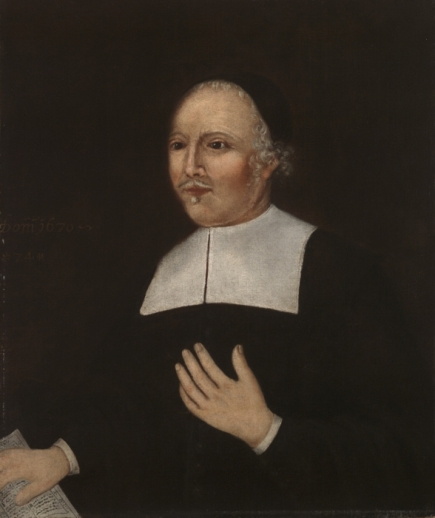By Nancy Finlay
It was an unusual thing to have one’s portrait painted in the 17th century. There were not a lot of portrait painters, especially in the American colonies, and portraits were expensive. But even though there is not an authentic portrait of Thomas Hooker, the founder of Hartford, there exists a portrait of New Haven’s founder John Davenport–created shortly before or shortly after Davenport’s death in 1670. The black robe and broad white collar match the common stereotype of a Puritan minister, but otherwise the portrait does not fit the stereotype at all. It shows a rather portly man with close-set eyes, a long nose, a wispy mustache, a small beard, and thinning gray hair. Despite the artist’s evident lack of training and artistic skill, we know what John Davenport looked like, and it is not what one might expect.
Although John Davenport sometimes comes across as the most puritanical of the Puritan founders, he did not start out that way. Born in Coventry, England, in April 1597, Davenport trained for the ministry at Oxford. By 1624, he was vicar of Saint Stephen’s Church in London, where his popular sermons attracted a broad audience of both rich and poor. While Puritan theology attracted him, he seemed more willing than many of his contemporaries to tolerate different practices in order to maintain unity within the English Church.
A New Colony on Long Island Sound
About 1629, Davenport joined with other ministers in an attempt to convince Thomas Hooker and John Cotton to remain in England. But not only did Hooker and Cotton immigrate to Holland rather than stay and compromise their beliefs, they convinced Davenport not to compromise beliefs of his own. These included the authority of the Church to require ceremonies not described in the Bible, and the power of bishops to override the decisions of an individual congregation. Davenport wound up following Hooker and Cotton first to Holland, and eventually to Massachusetts Bay. He arrived in Boston at the end of June 1637 and in the spring of 1638 set out with a group of followers to establish a new colony on Long Island Sound.
Davenport’s ideas did much to shape the town and colony of New Haven. The first settlers pledged themselves to direct all their affairs according to the Scriptures. Founders designed the town itself (with its nine squares) to reflect the plan of the encampment of the Israelites in the wilderness, the Temple of Solomon, and the New Jerusalem as described by John in the book of Revelation. They intended the physical form of the town to inspire its inhabitants to lead godly lives.

A Plan of the Town of New Haven with All the Buildings in 1748 by James Wadsworth. New Haven, CT: T. Kensett, 1806 – University of Connecticut Libraries, Map and Geographic Information Center (MAGIC) from the Map Collection, Yale University Library
Like many New Englanders, Davenport also welcomed the Protectorate of Oliver Cromwell, and believed that the judges who voted for the death of Charles I did their duty as good Puritans. When Cromwell’s government fell and the monarchy returned, leaders in Boston and Hartford quickly realized the necessity of recognizing the new regime. New Haven proved slow to recognize the new monarch, however, and Davenport persisted in aiding the regicide judges of Charles I, Goffe and Whalley, when they fled to New England. Unfortunately for Davenport, the 1662 charter granted to the Colony of Connecticut by the returning monarch (Charles II) effectively put an end to the Colony of New Haven, incorporating it into its larger neighbor effective in 1665.
Leaving the Colony of New Haven for Boston
By then Davenport was over 60 and in poor health. He might have remained in New Haven, where most in his congregation still held him in high esteem, but the First Church in Boston, the most influential Puritan church in the New World, sought a new minister, and the older, more conservative members issued an invitation to John Davenport.
Davenport’s arrival precipitated a schism in the Boston church, however. Furthermore, Davenport’s New Haven congregation proved reluctant to release him, and their letter expressing dissatisfaction with Davenport’s move led to further controversy. The ailing minister died suddenly, however, in April 1670, while the arguments still continued.
Greatly admired in his lifetime, Davenport became largely forgotten after his death. His colony of New Haven was a failure and the ideals that he so fervently believed in were no longer in favor. In the minds of the younger generation he was part of the past, notable chiefly for his resistance to change. Yet in his day he was an influential figure, the equal of Hooker and Cotton and other prominent Puritan leaders during the early years of the New England colonies, and his surviving writings provide a wealth of information about this important formative period in Connecticut’s history.
Nancy Finlay grew up in Manchester, Connecticut. She has a BA from Smith College and an MFA and PhD from Princeton University. From 1998 to 2015, she was Curator of Graphics at the Connecticut Historical Society.









